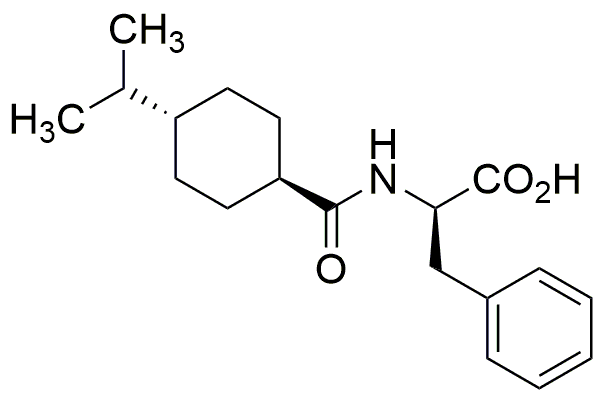Nateglinide is widely utilized in research focused on:
- Diabetes Management: Primarily used as an oral medication for type 2 diabetes, it helps control blood sugar levels by stimulating insulin release from the pancreas after meals.
- Pharmaceutical Development: Researchers are exploring its potential in combination therapies to enhance glycemic control, making it a valuable compound in drug formulation studies.
- Clinical Trials: Nateglinide is often included in clinical trials to assess its efficacy and safety, providing critical data for diabetes treatment advancements.
- Patient Compliance: Its rapid action and short duration of effect make it easier for patients to manage their blood sugar levels, addressing the challenge of adherence to medication regimens.
- Comparative Studies: It serves as a benchmark in studies comparing new antidiabetic agents, allowing researchers to evaluate the effectiveness of newer drugs against established treatments.
General Information
Properties
Safety and Regulations
Applications
Nateglinide is widely utilized in research focused on:
- Diabetes Management: Primarily used as an oral medication for type 2 diabetes, it helps control blood sugar levels by stimulating insulin release from the pancreas after meals.
- Pharmaceutical Development: Researchers are exploring its potential in combination therapies to enhance glycemic control, making it a valuable compound in drug formulation studies.
- Clinical Trials: Nateglinide is often included in clinical trials to assess its efficacy and safety, providing critical data for diabetes treatment advancements.
- Patient Compliance: Its rapid action and short duration of effect make it easier for patients to manage their blood sugar levels, addressing the challenge of adherence to medication regimens.
- Comparative Studies: It serves as a benchmark in studies comparing new antidiabetic agents, allowing researchers to evaluate the effectiveness of newer drugs against established treatments.
Documents
Safety Data Sheets (SDS)
The SDS provides comprehensive safety information on handling, storage, and disposal of the product.
Product Specification (PS)
The PS provides a comprehensive breakdown of the product’s properties, including chemical composition, physical state, purity, and storage requirements. It also details acceptable quality ranges and the product's intended applications.
Certificates of Analysis (COA)
Search for Certificates of Analysis (COA) by entering the products Lot Number. Lot and Batch Numbers can be found on a product’s label following the words ‘Lot’ or ‘Batch’.
*Catalog Number
*Lot Number
Certificates Of Origin (COO)
This COO confirms the country where the product was manufactured, and also details the materials and components used in it and whether it is derived from natural, synthetic, or other specific sources. This certificate may be required for customs, trade, and regulatory compliance.
*Catalog Number
*Lot Number
Safety Data Sheets (SDS)
The SDS provides comprehensive safety information on handling, storage, and disposal of the product.
DownloadProduct Specification (PS)
The PS provides a comprehensive breakdown of the product’s properties, including chemical composition, physical state, purity, and storage requirements. It also details acceptable quality ranges and the product's intended applications.
DownloadCertificates of Analysis (COA)
Search for Certificates of Analysis (COA) by entering the products Lot Number. Lot and Batch Numbers can be found on a product’s label following the words ‘Lot’ or ‘Batch’.
*Catalog Number
*Lot Number
Certificates Of Origin (COO)
This COO confirms the country where the product was manufactured, and also details the materials and components used in it and whether it is derived from natural, synthetic, or other specific sources. This certificate may be required for customs, trade, and regulatory compliance.


